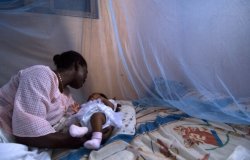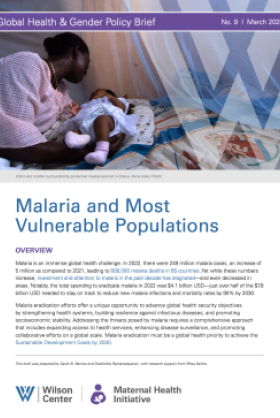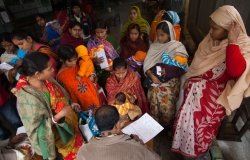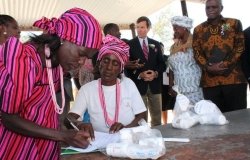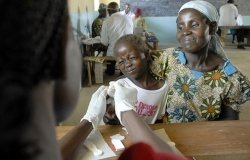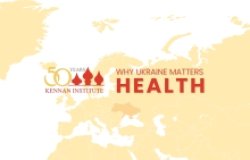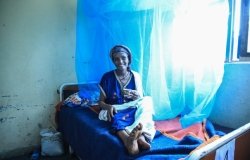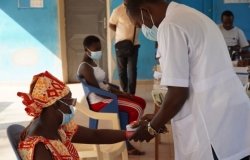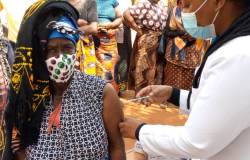Reality Check: Challenges and Innovations in Addressing Postpartum Hemorrhage
Cathy Solter, Senior Fellow, Pathfinder International;Sudhir Maknikar, Pathfinder International India;Deborah Armbruster, Sr. Maternal and Newborn Health Advisor, U.S. Agency for International Development;Suellen Miller, Director of Safe Motherhood Programs, Bixby Center for Global Reproductive Health; Farouk Jega, Pathfinder International Nigeria;Paul LaBarre, Technical Officer, PATH;Jennifer Blum, Senior Program Associate, Gynuity Health Projects;Ndola Prata, Medical Director, Venture Strategies Innovation;Shabnam Shahnaz, Pathfinder International Bangladesh
Overview
Heavy bleeding after childbirth, also known as postpartum hemorrhage (PPH), is one of the leading causes of maternal deaths worldwide. Globally, approximately 25 percent of all maternal deaths are caused by postpartum hemorrhage, and many mothers bleed to death due to delays in seeking health care services. On January 25th, 100 representatives from the maternal health community – a majority working directly in developing countries – convened for an all-day meeting at the Woodrow Wilson International Center for Scholars to discuss experiences in the field and perform "reality checks" on the challenges and successes of PPH programs.
Supported by Pathfinder International and the Wilson Center's Global Health Initiative, the conference drew on in-country examples and highlighted innovative interventions and technologies, including the appropriate use of Misoprostol, provision of safe birthing kits, training of providers through clinical drills, and the use of Non-Pneumatic Anti-Shock Garments (NASGs), as well as the need for greater family and community engagement, clinical education, and government support.
Innovative Solutions: The Continuum of Care Model
Pathfinder International's Clinical and Community Action Model to Address Postpartum Hemorrhage (CC-PPH) is a package of interventions that supplements clinical interventions to prevent, identify, and manage postpartum hemorrhage with community engagement and mobilization and government advocacy. CC-PPH is "comprehensive, practical, and adaptable," and though they have less of an impact if implemented individually, the "elements together can have significant impact on maternal mortality," said Kathy Solter, senior fellow at Pathfinder International.
Throughout the day, panelists provided field examples of the successes and challenges of several clinical interventions that reduced the incidence of postpartum hemorrhage through prevention, identification, and management, while also working to engage families, communities, and policymakers.
Preventing, Identifying, and Managing PPH
 Active management of the third stage of labor, AMTSL, is a key component of CC-PPH and a "high impact, evidence-based intervention," said Deborah Armbruster, senior maternal and newborn health advisor at the U.S. Agency for International Development. AMTSL includes three steps: the administration of a uterotonic drug, controlled cord traction, and uterine massage after delivery, and should be offered to every woman, at every birth, as the vast majority of postpartum hemorrhage cannot be predicted in advance. To make this safe, cost-effective, and sustainable intervention a reality, however, the maternal health community needs to develop "creative and alternative ways" to improve advocacy, training, and service delivery, said Armbruster.
Active management of the third stage of labor, AMTSL, is a key component of CC-PPH and a "high impact, evidence-based intervention," said Deborah Armbruster, senior maternal and newborn health advisor at the U.S. Agency for International Development. AMTSL includes three steps: the administration of a uterotonic drug, controlled cord traction, and uterine massage after delivery, and should be offered to every woman, at every birth, as the vast majority of postpartum hemorrhage cannot be predicted in advance. To make this safe, cost-effective, and sustainable intervention a reality, however, the maternal health community needs to develop "creative and alternative ways" to improve advocacy, training, and service delivery, said Armbruster.
 With the "imperative need to address home births with quality interventions," Misoprostol is a "game changer," said Ndola Prata, medical director at Venture Strategies Innovation. There is still much to learn about the clinical uses of Misoprostol for treating postpartum hemorrhagic symptoms, but, "providers and policymakers need to advocate for making both Oxytocin and Misoprostol more widely available, because they both have advantages in certain situations,"
With the "imperative need to address home births with quality interventions," Misoprostol is a "game changer," said Ndola Prata, medical director at Venture Strategies Innovation. There is still much to learn about the clinical uses of Misoprostol for treating postpartum hemorrhagic symptoms, but, "providers and policymakers need to advocate for making both Oxytocin and Misoprostol more widely available, because they both have advantages in certain situations,"  said Jennifer Blum, senior program associate at Gynuity Health Projects.
said Jennifer Blum, senior program associate at Gynuity Health Projects.
 The use of Safe Birthing Kits and Misoprostol for home deliveries is a critical part of the continuum of care for prevention and management of postpartum hemorrhage, said Shabnam Shahnaz, senior program associate for Pathfinder International, especially in places like Bangladesh, where 82 percent of deliveries occur in the home with unskilled birth attendants.
The use of Safe Birthing Kits and Misoprostol for home deliveries is a critical part of the continuum of care for prevention and management of postpartum hemorrhage, said Shabnam Shahnaz, senior program associate for Pathfinder International, especially in places like Bangladesh, where 82 percent of deliveries occur in the home with unskilled birth attendants.
 "Postpartum hemorrhage is not a routine event in many settings and periodic drills can help trained providers maintain their skills," said Suellen Miller, director of Safe Motherhood Programs at the Bixby Center for Global Reproductive Health. Clinical drills conducted at periodic, ongoing trainings provide "practical sessions in problem solving that take theory into practice" and can help clinicians develop and retain the critical skills needed to implement effective interventions, said Miller.
"Postpartum hemorrhage is not a routine event in many settings and periodic drills can help trained providers maintain their skills," said Suellen Miller, director of Safe Motherhood Programs at the Bixby Center for Global Reproductive Health. Clinical drills conducted at periodic, ongoing trainings provide "practical sessions in problem solving that take theory into practice" and can help clinicians develop and retain the critical skills needed to implement effective interventions, said Miller.
 NASGs, can help treat shock, resuscitate, stabilize, and prevent further bleeding in women with any form of obstetric hemorrhage and may "help clinicians to stabilize patients in shock before getting definitive treatment or getting transferred [to a health facility],"said Farouk Jega, program manager for Pathfinder International Nigeria. After transfer, a B-Lynch suture is a simple, cost effective technique used in surgery with NASG that preserves future fertility, said Jega, though not all providers are trained and comfortable with this relatively new procedure. Although the high cost of NASGs, logistic inefficiencies, and quality issues have been challenges in the past, there has been progress toward making an affordable, quality NASG, according to Paul LaBarre, technical officer at PATH. "The maternal health community must address misperceptions and implementation barriers and ensure that they necessary systems are in place to successfully implement NASGs," said Miller.
NASGs, can help treat shock, resuscitate, stabilize, and prevent further bleeding in women with any form of obstetric hemorrhage and may "help clinicians to stabilize patients in shock before getting definitive treatment or getting transferred [to a health facility],"said Farouk Jega, program manager for Pathfinder International Nigeria. After transfer, a B-Lynch suture is a simple, cost effective technique used in surgery with NASG that preserves future fertility, said Jega, though not all providers are trained and comfortable with this relatively new procedure. Although the high cost of NASGs, logistic inefficiencies, and quality issues have been challenges in the past, there has been progress toward making an affordable, quality NASG, according to Paul LaBarre, technical officer at PATH. "The maternal health community must address misperceptions and implementation barriers and ensure that they necessary systems are in place to successfully implement NASGs," said Miller.
Engaging Communities and Policymakers
 But challenges to implementation of these interventions still exist, which will require both government support and community mobilization to overcome. "Postpartum hemorrhage prevention and treatment solutions exist, but 14,000 women die each year from a lack of implementation of these solutions," said Blami Dao, director of Maternal and Newborn Health at Jhpiego.
But challenges to implementation of these interventions still exist, which will require both government support and community mobilization to overcome. "Postpartum hemorrhage prevention and treatment solutions exist, but 14,000 women die each year from a lack of implementation of these solutions," said Blami Dao, director of Maternal and Newborn Health at Jhpiego.
Competing health priorities, the complexity of maternal health products, staff changes, and disasters can make it difficult to engage government officials. "Ultimately, successful advocacy with the government promoting and enabling policies will prevent mothers from dying of PPH," said Sudhir Maknikar, project leader for Pathfinder International India. From the onset of interventions to reduce postpartum hemorrhage, maternal health experts must successfully engage government as a "vital partner," he added.
The maternal health community must also "increase awareness of technologies and mobilize the community to be able to access health facilities and care when emergencies arise" said Jega. Financial constraints, migration, poor referral systems, and transportation issues make it difficult for pregnant women to seek timely and appropriate care. The maternal health community should work to create an enabling environment by orienting community and household-level decision-makers as well as disseminate key health messages through active involvement of front line health workers and local NGOs, said Maknikar.
To expand effective programs and ensure that effective interventions reach pregnant women, it is critical the maternal health community advocates for policy changes that encourage national expansion, standardize provider training, engage community and family decision-makers, improve availability and access to commodities, and lead to an effective monitoring and evaluation system. Combined interventions at the clinical, community, and policy levels can together have a major impact on reducing maternal mortality.
The Wilson Center's Global Health Initiative will continue to highlight innovative maternal health strategies and increase voices from the field through its upcoming 2011 maternal health series, "Advancing Policy Dialogue on Maternal Health: Voices from the Field," in collaboration with its co-conveners, the Maternal Health Task Force and United Nations Population Fund.
Drafted by Ramona Godbole, ECSP and GHI Intern
Calyn Ostrowski, Global Health Initiative, 202-691-4341
Documents & Downloads
- Reality Check: Challenges and Innovations in Addressing Postpartum HemorrhageDownload
- Reality Check: Challenges and Innovations in Addressing Postpartum HemorrhageDownload
- Reality Check: Challenges and Innovations in Addressing Postpartum HemorrhageDownload
- Reality Check: Challenges and Innovations in Addressing Postpartum HemorrhageDownload
- Reality Check: Challenges and Innovations in Addressing Postpartum HemorrhageDownload
- Reality Check: Challenges and Innovations in Addressing Postpartum HemorrhageDownload
- Reality Check: Challenges and Innovations in Addressing Postpartum HemorrhageDownload
- Reality Check: Challenges and Innovations in Addressing Postpartum HemorrhageDownload
- Reality Check: Challenges and Innovations in Addressing Postpartum HemorrhageDownload
- Reality Check: Challenges and Innovations in Addressing Postpartum HemorrhageDownload
- Reality Check: Challenges and Innovations in Addressing Postpartum HemorrhageDownload
- Reality Check: Challenges and Innovations in Addressing Postpartum HemorrhageDownload
- Reality Check: Challenges and Innovations in Addressing Postpartum HemorrhageDownload
- Reality Check: Challenges and Innovations in Addressing Postpartum HemorrhageDownload
- Reality Check: Challenges and Innovations in Addressing Postpartum HemorrhageDownload
- Reality Check: Challenges and Innovations in Addressing Postpartum HemorrhageDownload
- Reality Check: Challenges and Innovations in Addressing Postpartum HemorrhageDownload
- Reality Check: Challenges and Innovations in Addressing Postpartum HemorrhageDownload
- Reality Check: Challenges and Innovations in Addressing Postpartum HemorrhageDownload
- Reality Check: Challenges and Innovations in Addressing Postpartum HemorrhageDownload
- Reality Check: Challenges and Innovations in Addressing Postpartum HemorrhageDownload
- Reality Check: Challenges and Innovations in Addressing Postpartum HemorrhageDownload
- Reality Check: Challenges and Innovations in Addressing Postpartum HemorrhageDownload
Hosted By

Maternal Health Initiative
Life and health are the most basic human rights, yet disparities between and within countries continue to grow. No single solution or institution can address the variety of health concerns the world faces. By leveraging, building on, and coordinating the Wilson Center’s strong regional and cross-cutting programming, the Maternal Health Initiative (MHI) promotes dialogue and understanding among practitioners, scholars, community leaders, and policymakers. Read more
Thank you for your interest in this event. Please send any feedback or questions to our Events staff.
